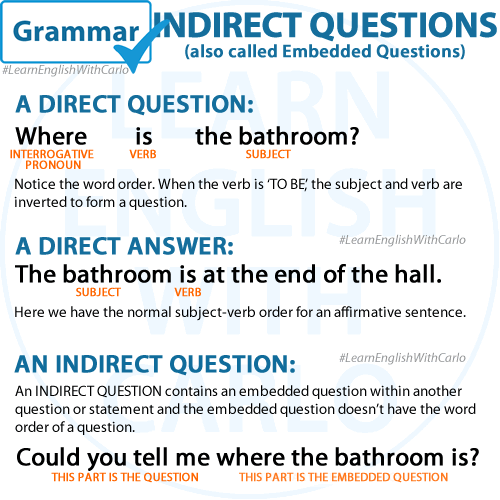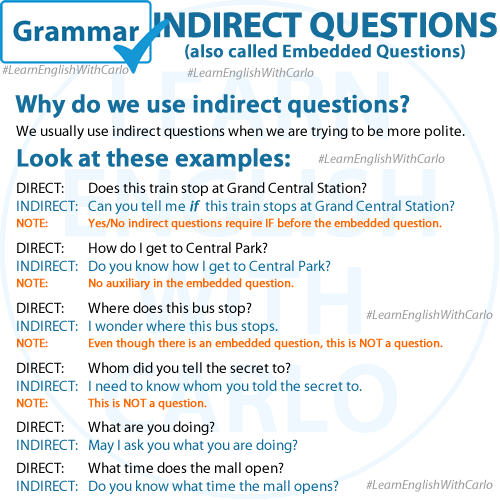Indirect questions are a polite and often more formal way of asking questions. They differ from direct questions in their structure and use. Let’s break down what indirect questions are, how to form them, and provide examples to illustrate their use.


What Are Indirect Questions?
Indirect questions are questions embedded within statements or other questions. They are commonly used to show politeness or to soften the impact of a question. Instead of asking a question directly, you rephrase it in a way that makes it sound less direct and more courteous.
Direct vs. Indirect Questions
Direct Question: Where is the nearest bank?
Indirect Question: Could you tell me where the nearest bank is?
Notice the difference:
- The direct question is straightforward and to the point.
- The indirect question is introduced by a polite phrase and follows a statement structure.
How to Form Indirect Questions
To form an indirect question, follow these steps:
- Start with a polite phrase:
- Could you tell me…
- Do you know…
- I wonder…
- Can you explain…
- Follow with the subject and verb, avoiding inversion:
- Direct: What time is it?
- Indirect: Do you know what time it is?
- Use ‘if’ or ‘whether’ for yes/no questions:
- Direct: Is it going to rain today?
- Indirect: Do you know if it is going to rain today?
Examples of Indirect Questions
Here are some examples of how direct questions are transformed into indirect questions:
- Direct: Where does she live?
Indirect: Can you tell me where she lives? - Direct: Why did they leave early?
Indirect: Do you know why they left early? - Direct: Did he finish the project?
Indirect: Could you let me know if he finished the project? - Direct: What is your name?
Indirect: I’d like to know what your name is. - Direct: When is the meeting?
Indirect: Do you have any idea when the meeting is?
Tips for Using Indirect Questions
- Maintain Politeness: Use indirect questions to be more polite, especially in formal situations or when speaking to someone you don’t know well.
- No Auxiliary Verbs in the Question Part: Unlike direct questions, indirect questions do not use auxiliary verbs like ‘do’ or ‘does’ after the polite phrase.
- Tense Consistency: Ensure that the tense of the question remains consistent. The polite phrase does not change the tense of the question itself.
